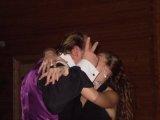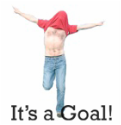
Balls. I seem to have been to a lot of them this year. Last Friday was the NSPCC Snowflake Ball, an annual event which raises substantial sums to look after young people in distress.
Sitting at the table my thoughts turned to balls again, though this time those of a spherical kind. When I was asked who I was sitting with I said "Oh it's a guy called Dean. I've never met him before but I would wager that he was a footballer". My questioner tried to deduce how I had come to that conclusion. "Is it the expensive watch?" he asked "No" I said. "Okay, the expensive watch and the glamourous wife" he proferred "No" I said. "Ah, he's not drinking" came as a final throw of the dice. "No" I said "It's because I've been looking at his fingers".
It's true. I've found myself looking at people's fingers ever since I attended another ball in Derby some months back. I was sitting with my old friend Lee Glover, a former professional footballer now coaching youngsters at Derby County. During a lull in proceedings he posed me a question "How would you find someone who had the potential to be a professional footballer - or for that matter any elite athlete?".
I couldn't believe my luck as I prepared to deliver the answer. All of those years of looking in the index of the Rothman's Football Yearbook carefully correlating the birthplace of registered professional footballers with the Government Index of Multiple Deprivation had finally paid off. So I wrapped up my answer and delivered it with an air of authority "Once we would have said you find them where there is no central heating. Now everybody has central heating so you find them in places where there are a lot of TV satellite dishes with high scores on the deprivation index". I think I added a few references to Darwin's Origin of the Species to make it sound even more plausible.
Lee smiled Knowingly, politely waited until I had finished my speech and then simply said "No. Look at their fingers". It seems that a psychologist, Professor John Manning, has noted that top athletes tend to have an elongated ring finger. This is due to them absorbing more testosterone whilst in the womb, which increases their probabaility of being successful in the comepetitive arena of top class sport. Lee has been looking at player's fingers and he estimates that about 85% have the elongated finger.
So, back to The Snowflake, I had noticed that Dean had an elongated finger. Had I placed my wager on him being a professional footballer I would have won. He played for Ajax Amsterdam before turning out for a string of English teams none of which sounded quite as romantic or for that matter had any positive effect on kitchen floors.
It makes me wonder why we don't use this powerful piece of information. We have an Olympic games coming up in 2012 and yet we insist on telling schoolchildren that they may be able to compete. In truth, it is primarily the 'long fingers' who have a chance to compete at elite level, so why don't we focus our scarce resources on them? Instead we throw everybody into school sport and then wonder why a lot of people grow up hating it. The answer lies in their fingers and the humiliation and despair that many young people experience when trying to compete with 'long fingers'.
In our rush to find the next Tom Daley, we risk putting a lot of young people off sport. So the positive effect that the Olympics has in increasing particpation may actually end up as a zero sum game. The answer is simple. Find the 'long fingers' and put them in a place where they can compete with each other, leaving everybody else to find something physical that they truly enjoy.
Finding your finger ratio
Place your right hand palm up Measure the length of your index finger, from where it joins your palm to the tip
Measure your ring finger in the same way
Divide the length of the index finger by that of the ring finger to calculate your ‘finger ratio'
The average ratio for women is 1 The average ratio for men is 0.98. Top athletes will have a ratio closer to 0.9.
Sitting at the table my thoughts turned to balls again, though this time those of a spherical kind. When I was asked who I was sitting with I said "Oh it's a guy called Dean. I've never met him before but I would wager that he was a footballer". My questioner tried to deduce how I had come to that conclusion. "Is it the expensive watch?" he asked "No" I said. "Okay, the expensive watch and the glamourous wife" he proferred "No" I said. "Ah, he's not drinking" came as a final throw of the dice. "No" I said "It's because I've been looking at his fingers".
It's true. I've found myself looking at people's fingers ever since I attended another ball in Derby some months back. I was sitting with my old friend Lee Glover, a former professional footballer now coaching youngsters at Derby County. During a lull in proceedings he posed me a question "How would you find someone who had the potential to be a professional footballer - or for that matter any elite athlete?".
I couldn't believe my luck as I prepared to deliver the answer. All of those years of looking in the index of the Rothman's Football Yearbook carefully correlating the birthplace of registered professional footballers with the Government Index of Multiple Deprivation had finally paid off. So I wrapped up my answer and delivered it with an air of authority "Once we would have said you find them where there is no central heating. Now everybody has central heating so you find them in places where there are a lot of TV satellite dishes with high scores on the deprivation index". I think I added a few references to Darwin's Origin of the Species to make it sound even more plausible.
Lee smiled Knowingly, politely waited until I had finished my speech and then simply said "No. Look at their fingers". It seems that a psychologist, Professor John Manning, has noted that top athletes tend to have an elongated ring finger. This is due to them absorbing more testosterone whilst in the womb, which increases their probabaility of being successful in the comepetitive arena of top class sport. Lee has been looking at player's fingers and he estimates that about 85% have the elongated finger.
So, back to The Snowflake, I had noticed that Dean had an elongated finger. Had I placed my wager on him being a professional footballer I would have won. He played for Ajax Amsterdam before turning out for a string of English teams none of which sounded quite as romantic or for that matter had any positive effect on kitchen floors.
It makes me wonder why we don't use this powerful piece of information. We have an Olympic games coming up in 2012 and yet we insist on telling schoolchildren that they may be able to compete. In truth, it is primarily the 'long fingers' who have a chance to compete at elite level, so why don't we focus our scarce resources on them? Instead we throw everybody into school sport and then wonder why a lot of people grow up hating it. The answer lies in their fingers and the humiliation and despair that many young people experience when trying to compete with 'long fingers'.
In our rush to find the next Tom Daley, we risk putting a lot of young people off sport. So the positive effect that the Olympics has in increasing particpation may actually end up as a zero sum game. The answer is simple. Find the 'long fingers' and put them in a place where they can compete with each other, leaving everybody else to find something physical that they truly enjoy.
Finding your finger ratio
Place your right hand palm up Measure the length of your index finger, from where it joins your palm to the tip
Measure your ring finger in the same way
Divide the length of the index finger by that of the ring finger to calculate your ‘finger ratio'
The average ratio for women is 1 The average ratio for men is 0.98. Top athletes will have a ratio closer to 0.9.

 RSS Feed
RSS Feed



